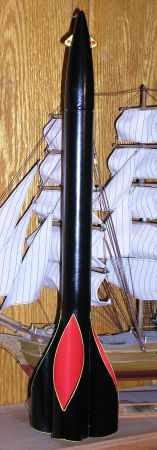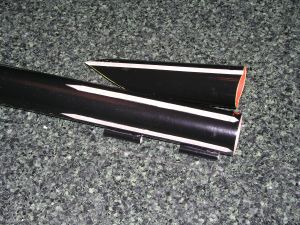| Construction Rating: | starstarstarstarstar |
| Flight Rating: | starstarstarstarstar_border |
| Overall Rating: | starstarstarstarstar_border |
| Manufacturer: | Pemberton Technologies  |

Brief:
Probably no legendary sea monster was as horrifying as the Kraken. According to stories, this huge, many armed
creature could reach as high as the top of a sailing ship's main mast. Well, this rocket may not have many arms, but it
will fly higher than a ship's main mast!
This is my first kit from Pemberton Technologies, but it won't be my last. They even supplied RockSim files, that they graciously allowed me to include with this review.
The Kraken is a single stage tube fin rocket. I felt what made it unique was how the tube fins were pointed.
Construction:
The rocket came with 2 BT-60 body tubes, one of which will be cut up into the tube fins, a 24mm motor tube with 2
centering rings, a balsa wood nose cone with a screw eye and a washer for weight, two 1/4" launch lugs, 60"
of Kevlar®
cord, and an 18" plastic parachute. There is a little piece of balsa wood for the canards. It also came with one
of the most amusing set of instructions (or destructions as they call it) that added to the fun of building this kit.
The Kraken comes with 19 pages of destructions including a photo quality picture of the Kraken. The most difficult part of this rocket is cutting the tube fins. Nine of the destruction pages provide instructions, photos, drawings, cave sketches, etc. to help you mark and cut the one tube into 4 tube fins. With all the information presented, making the tube fins really is not that difficult. Make sure you use a sharp knife and take your time. You mark a line along the length of the tube on the top and bottom. Marks are made at different positions and you need to draw lines between the appropriate top and bottom marks. This creates the unique pointed tube fins.
There is a pattern for cutting the canards. I decided to round the edges of the canards. These glue onto the balsa nose cone. I used thick CA to bond the canards since I was using thin CA to seal the balsa nose cone.
Next is the motor mount. Glue on the 2 centering rings. You carve a notch in the top one, tie the Kevlar® cord around the motor tube and pass the cord through the notch. Then glue the motor mount into the body. Notice I didn't mention anything about a thrust ring or motor retainer? Well, there are no such things for this kit. The destructions warn you to avoid pitchforks, torches, and mob mentality, and simply use masking tape or duct tape to create a thrust ring on the motor itself. To hold the motor in place, the instructions say to wrap a bit of tape between the motor tube and this thrust ring you created.
I finished my rocket before I glued the tube fins on. This makes it easier to get complete paint coverage. When I did glue the tube fins on, I opted to use 12 minute epoxy since I would not be able to fillet the joints with the paint.
The nose weight is a fender washer. This gets glued to the nose cone and a screw eye goes into the nose cone. The Kevlar® cord ties to the screw eye. Unlike most folks who hate elastic, I added some in parallel to the Kevlar® to absorb some of the ejection shock.

Finishing:
The biggest issue with finishing a tube fin rocket is getting paint under the tubes. The method I used was to mask
off a glue strip with masking tape and then paint the pieces before gluing them together. I first filled the tube
spirals with Elmer's Wood Filler and sanded with different grades of sandpaper down to 320 grit, making sure to get
inside the tube fins. The inside of the tube fins were primed and sanded with 400 grit then painted with gloss red. I
used Krylon for all my painting. After the paint was dry, I masked the inside of the tube. I then used some 1"
wide tape that I cut down into 1/4" strips to create the glue strips. I beveled the top and bottom to match the
tube fins, but I also made the strips about 1/4" short to make sure I would not leave a gap. I then primed and
painted the outside of the tube fins and the body gloss black. I used multiple coats of thin CA to seal the balsa nose
cone and sanded down with 400 grit. The nose cone was also painted gloss black. As a finishing touch, I used a Testor's
Gloss Yellow Enamel Paint Marker and rimmed the tube fins. I also used the marker to paint the canards and followed
that with a red paint marker to make some eyes for this evil beast.
Construction Rating: 5 out of 5
Flight:
The recommended motors range from an Estes C11 to AeroTech's E15. I went to my favorite local field where it was 24
degrees with a light covering of snow. I prepared some masking tape to use as the thrust ring in the comfort of my warm
house before I left. I used my Estes E size pad with it's 6' x 1/4" rod. I set up in the middle of the field and
prepped a D12-3. I tried the method of using tape around the motor mount and engine to secure the motor that was
suggested by the destructions. Some dog barf and parachute (I cheated here and used an existing 18" Estes chute I
have on a snap swivel)in the other end. An igniter into the motor, onto the launch pad, and a countdown from 5. The
rocket left the launch pad for a beautiful straight flight.
Recovery:
Right before apogee, the ejection charge went off. The engine came out one end, but fortunately the nose cone and
parachute came out the other end. The parachute did not open, but the drag from the closed parachute and the separate
pieces still had the rocket coming down somewhat slowly. Finally, about 20' above the ground the parachute finally
opened. The rocket landed standing up in the snow without any damage. For the second and third flights, I changed to
friction fitting the motors. I also put the parachute in my pocket while I was prepping everything so it would be less
stiff. My second flight was also a D12-3. Again, a perfectly straight launch and this time the engine stayed in and the
parachute opened right away. And then it took a long time to land with a little longer walk to recover it. I was
thinking of trying an E11, but the wind started picking up so I used a D12-3 for the third flight as well. Again a nice
straight launch. But with the stronger wind, the rocket drifted away some. I think an 18" chute is a tad too big
for this rocket. I didn't try a fourth flight--my toes were freezing, but I would be tempted to try a 12" or
14" chute instead of the 18" chute supplied with the kit.
Flight Rating: 4 out of 5
Summary:
This is a fun rocket with its unique tube fins. The rocket goes together simply (after you cut the fins). Due to the
fins, I would rate this rocket construction complexity as a 3. The quality parts and amusing destructions made the
construction enjoyable. Unless you do something to add a lot of weight, I would suggest a smaller parachute or else
make sure there are no winds unless you like to go hiking. I look forward to building other kits from Pemberton.
Overall Rating: 4 out of 5
Other Reviews
- Pemberton Technologies Kraken By Jeff Boldig (March 15, 2008)
Construction and Finishing: The package was shipped with no damage. Packaging was excellent. The instructions were clear throughout and were injected with a lot of humor. This was a good thing for me because it fits right in with my sense of humor and added to my enjoyment of the kit. Your mileage may vary. The instructions start out with a complete parts list including the fin ...
 |
 |
Flights
 |
 |
B.C. (March 4, 2008)
J.T. (March 27, 2008)
PEM. Tech. (April 6, 2008)
A.H. (September 28, 2008)
 |
 |
K.G. (February 27, 2008)